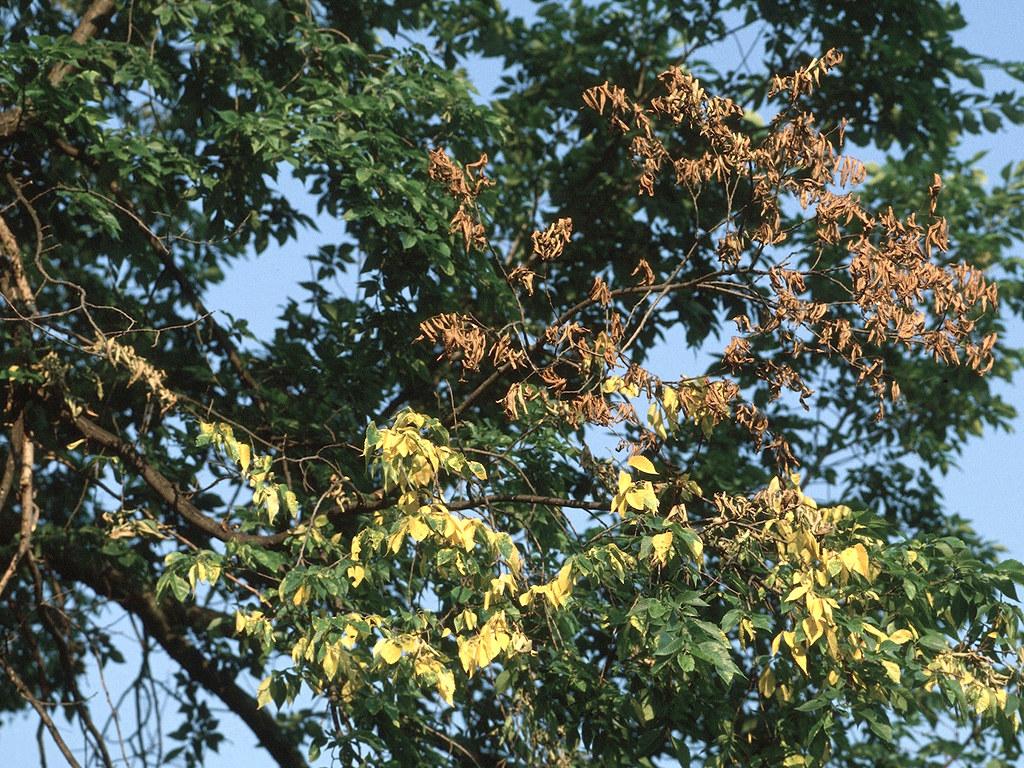
Dutch elm disease
Ophiostoma ulmi
What is Dutch Elm disease (Ophiostoma ulmi)?
Dutch elm disease (DED) is a highly destructive disease caused by the fungi Ophiostoma novo-ulmi and Ophiostoma ulmi. It affects various species of elm trees, including English elm, field elm, and Wych elm. The disease is spread by elm bark beetles and has caused significant damage to elm populations worldwide. Symptoms of DED include wilting, yellowing, and premature loss of leaves, as well as the death of shoots and the formation of dark streaks or rings in affected twigs.
How does Dutch Elm disease (Ophiostoma ulmi) occur?
Dutch elm disease (DED) reproduces through a complex life cycle involving both the fungal pathogens and their insect vectors. The fungi produce spores within infected trees, which are then carried by bark beetles from infected to healthy elms during feeding. The beetles create tunnels in the tree's bark, allowing the fungi to enter and infect the tree's vascular system. The fungi then multiply, blocking the flow of water and nutrients, leading to the wilting and eventual death of the tree. The beetles continue to spread the disease by moving between infected and healthy trees.
Symptoms
1 - Plant and Tree Impact
• Dutch elm disease can cause the rapid decline and death of trees, including both mature and young specimens. • Infected trees lose their leaves and exhibit canopy thinning, leading to a significant loss of shade and aesthetic value. • Loss of trees can disrupt the balance and diversity of plant species within a habitat.
2 - Soil Impact
• The death and decay of infected trees can impact the nutrient cycling processes in the soil, potentially affecting other plant species. • The disease may alter the composition and activity of soil microorganisms, which play crucial roles in soil fertility and ecosystem functioning.
3 - Environmental Impact
• Dutch elm disease can result in the loss of suitable habitats for various organisms, such as birds, insects, and small mammals that depend on elm trees. • The removal of large trees can disrupt the microclimate within an area, affecting temperature, humidity, and wind patterns.
Solutions
1 - Prevention
• Use tree varieties that have shown resistance to Dutch elm diseases, such as the American Liberty Elm (Ulmus americana 'Liberty') or Princeton Elm (Ulmus americana 'Princeton'). • Regularly prune, trim elm trees, and destroy infected trees to maintain their health and vigor, reducing disease susceptibility. • Manage elm bark beetles through insecticide treatments or targeted insect control methods to limit their spread.
2 - Biological Control
• Biofungicides containing beneficial fungi, such as Beauveria bassiana or Trichoderma species, can suppress the growth of the Dutch elm disease fungus. These biofungicides help protect healthy elms from infection. Consult with professionals for proper application.
3 - Fungicidal Treatment:
Fungicides containing active ingredients like thiabendazole, propiconazole and Triadimefon can be applied to infected trees to suppress the growth and spread of the fungus. • Systemic fungicides can be injected directly into the trunk of infected trees, allowing the treatment to reach the entire vascular system and combat the disease. Consult with professionals for proper application.
